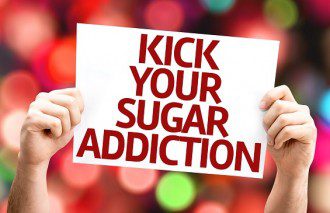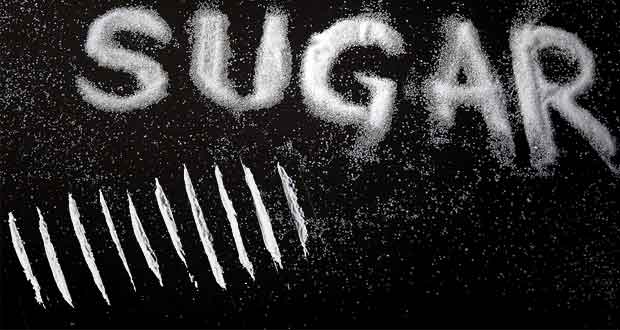Contributing writer for Wake Up World
“Some of the largest companies are now using brain scans to study how we react neurologically to certain foods, especially to sugar. They’ve discovered that the brain lights up for sugar the same way it does for cocaine.” ~ Michael Moss, Salt Sugar Fat: How the Food Giants Hooked Us
To our ancestors, sugar was a precious commodity. Infrequently found in high concentrations in a typical ancestral diet, substances like honey and ripe fruit were seasonal treats to be savoured, as a means to gain energy and build up fat stores before winter. Today our brains are still wired to want to maximise our sugar intake, but because it is now so processed, cheap and abundant, this once beneficial substance is wreaking havoc with our health. With the average daily sugar intake in the US equalling 32 teaspoons, most people eat more sugar in a week than our ancestors would have consumed in a lifetime.
[pro_ad_display_adzone id=”110028″]
Until very recently sugar was seen as a harmless additive that made food more fun and appealing. The idea ‘a spoonful of sugar helps the medicine go down’ was a popular notion, and products aimed at children were crammed with sugar in order to make them more appetizing to young palates. Children growing up in the seventies would commonly start the morning with a bowl of cereal with an already high sugar content, and then be handed the sugar bowl so that they could sprinkle even more on top. For many, this flow of refined sugar continued throughout the day in the form of candy, sweet drinks and hidden within most processed foods.
Now that these kids raised on copious amounts of sugar are nearing middle age, we are witnessing a massive surge in serious chronic health issues that is leading experts to re-think sugar’s benign reputation. With a slew of recent studies linking sugar to obesity, type-2 diabetes, heart disease, cancer, and even psychological disturbances, our perception of sugar is finally shifting from a tasty and fun additive, to a toxic and even addictive chemical.
Sugar Addiction and the Brain
A growing body of research has demonstrated that sugar interferes with the brain’s reward processing centre in a similar way that narcotics and recreational drugs do, with sugar addicts suffering uncomfortable withdrawal symptoms when they attempt to limit their intake. In fact, one addiction study showed that 93% of animal subjects regularly chose sugar water over cocaine.
This emerging view of sugar as an addictive and dangerous substance has led researchers to investigate ways to help people curb their sugar intake in the hopes of reversing this destructive trend. Recently, Queensland University of Technology (QUT) in Australia looked at the possibility of using drugs commonly used to treat nicotine addiction as a means to assist people to improve their health by reducing their cravings for sugar. This study, published in by international research journal PLOS ONE, found that smoking cessation drugs could also be used to treat sugar addiction in animals, clearly highlighting the similarities between sugar- and narcotic-addiction in the brain.
“The latest World Health Organisation figures tell us 1.9 billion people worldwide are overweight, with 600 million considered obese,” said Neuroscientist Professor Selena Bartlett from QUT’s Institute of Health and Biomedical Innovation.
“Excess sugar consumption has been proven to contribute directly to weight gain. It has also been shown to repeatedly elevate dopamine levels which control the brain’s reward and pleasure centres in a way that is similar to many drugs of abuse including tobacco, cocaine and morphine. After long-term consumption, this leads to the opposite, a reduction in dopamine levels. This leads to higher consumption of sugar to get the same level of reward.
“We have also found that… animals that maintain high sugar consumption… into adulthood may also face neurological and psychiatric consequences affecting mood and motivation.
“Our study found that… drugs like varenicline, a prescription medication trading as Champix which treats nicotine addiction (*), can work the same way when it comes to sugar cravings.”
PhD researcher Masroor Shariff pointed out that the study also put artificial sweeteners under scrutiny.
“Interestingly, our study also found that artificial sweeteners such as saccharin could produce effects similar to those we obtained with table sugar, highlighting the importance of reevaluating our relationship with sweetened food per se,” said Mr Shariff.
“Like other drugs of abuse, withdrawal from chronic sucrose exposure can result in an imbalance in dopamine levels and be as difficult as going ‘cold turkey’ from them,” Professor Selena Bartlett said.
(*) It must be noted, however, that while nicotine cessation drugs used in this study were shown to be effective in helping curb sugar addiction in animals, and have undoubtedly helped many people kick their dangerous smoking habit, these drugs are known to have adverse side-effects, including nausea, dizziness, seizures, diabetes, aggression, psychosis and suicidal thoughts.
Kicking the Habit, Without the Drugs
For those that want to limit their sugar intake without the use of prescription drugs, here are some strategies that can help.
First of all it is important to remember that not all sugar is created equal. Begin by identifying and eliminating the more toxic forms of sugar which include high fructose corn syrup, white sugar, and artificial sweeteners. Though too much of any type of sugar will contribute negatively to your health, try small amounts of sugars in their natural form. Honey, rapadura, coconut flower sugar, dates and maple syrup are superior choices.
Make a point of not buying any processed treats. If you are going to consume something sweet, make it yourself. This makes it more likely that sweets are not an everyday affair and that they are made with only high quality, healthful ingredients. A quick Google search will yield a plethora of delicious desserts that can be made with minimal added sugars (or check out our recipes section on Wake Up World.)
It is also a good idea to pay attention to cravings and the time they occur. When they strike, try drinking a glass of water instead of indulging in a sweet treat. If the water doesn’t cut it, have some non-sweetened snack food like nuts and seeds handy. Try to also avoid simple carbohydrates as they are converted to sugar by the body and have a similar effect on our blood sugar levels.
Emerging research suggests we would benefit from getting the majority of our day-to-day energy needs from saturated fats, not sugar, and from eating either an early evening meal or a delayed breakfast to increase the time of our nightly fast. These two simple measures let blood-glucose concentrations fall naturally, and foster an efficient metabolism that no longer needs sugar to allow the body to function optimally in our busy modern world.
Probiotics and fermented food can also help with sugar addiction as certain bacteria thrive on sugar and, according to current research, actually have the ability to influence our brains to align our cravings with their needs. By introducing fermented foods into our diets we can gradually replace our gut bacteria with ones that support, rather than hinder, our health. Probiotic bacteria also produce effective neurotransmitters such as dopamine and serotonin in the gut, and research indicates that communication via the vagus nerve (often called the connecting mechanism of the gut/brain axis) causes the brain to function as if these important substances were in the brain. So introducing fermented foods into our diet confers a twofold advantage if we seek to reduce our sugar intake. The ‘bad’ guys are replaced, along with their ability to make us crave sugar, and the ‘good’ guys offer us all the tools we need to kick the addiction.
As for the taste factor, once we have accustomed ourselves to a reduced-sugar diet, we generally find that that we are able to appreciate subtle levels of sweetness that previously we would have been unable to detect, and food that we once thought was delicious will likely seem sickeningly sweet.
Kick the junk to the kerb. Your body will thank you.
Referencess:
- http://www.eurekalert.org/pub_releases/2016-04/quot-tsa040616.php
- http://www.news-medical.net/news/2008/05/25/38637.aspx
- http://articles.mercola.com/sugar-side-effects.aspx
- http://fitness.mercola.com/sites/fitness/archive/2012/08/10/fat-not-glucose.aspx
- https://authoritynutrition.com/23-studies-on-low-carb-and-low-fat-diets/
- https://www.facebook.com/celestialroots/photos/pb.1449430158637199.-2207520000.1460767272./1743315632581982
- Dinan TG, Cryan JF (2013) Melancholic microbes: a link between gut microbiota and depression?. Neurogastroenterology and Motility 25(9):713-719.
- Dinan TG, Stanton C, Cryan JF (2013) Psychobiotics: a novel class of psychotropic. Biological Psychiatry 74(10):720-726.
About the author:
Christina Lavers is a writer, an artist, a creative enthusiast, and an inner world explorer. Born in Montreal Quebec, Canada, she now lives with her life partner and son in a rainforest pocket in the hills behind Coffs Harbour, NSW Australia. She spends her time playing, creating, growing and sharing.
Christina is devoted to assisting people to find and connect with their own creative magical current that flows deep within. She is now offering a comprehensive e-course designed to help people light up their world with passion and creativity. You can access Section One here for free!
Christina has also recently published her first full length book, a memoir about her wild awakening journey entitled Jump Into the Blue, and she is currently working on the next one.
“My journey has been about personal alchemy… exploring the mysteries of my soul and my environment, and learning to bring all aspects, the light and the dark, together with the transcending ingredient… love. The more I uncover and nurture the wounded aspects of my being, the more whole and grounded I feel and the more my outer world reflects the love, wonder and magic I have discovered inside”.
You can follow Christina’s work at:
Further reading from Christina Lavers:
- Are You a Bridge Between Two Worlds?
- Addictive Behavior Related to Low Levels of Oxytocin, the “Love/Bonding Hormone”
- 10 Signs You’ve Bought Spin
- New Study Shows Regular Contact with Nature Reduces Crime, Increases Social Cohesion
- Research Shows Just 7 Minutes of Meditation Can Reduce Racial Prejudice
- Taking Care of Our Inner Tribes – Microflora, Awakening and You
- Groundbreaking Study Maps the Decline of Wild Bee Communities in the United States
- Taking Responsibility For Our Energy
- More Evidence That TV is Dumbing Us Down
- Synchrony and Exertion of Dancing Found to Encourage Social Bonding, Raise Pain Threshold
- Quitting Smoking? Try These Herbs, Tips and Incentives to Help You Succeed!
[pro_ad_display_adzone id=”110027″]










